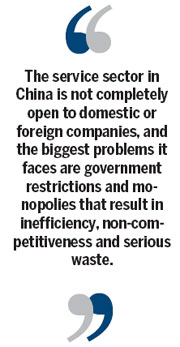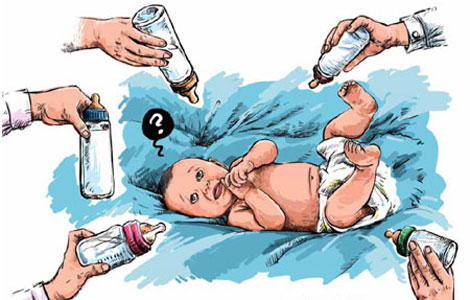Restricted sector may stunt growth
Updated: 2013-10-25 09:56
By Wu Jiangang (China Daily Europe)
|
|||||||||||
Chinese government has to open up service industry for new economic model to work
The possible crisis in Chinese manufacturing may present an opportunity for the service sector, which in the long term can save China. But in the short term, China first has to save the service sector.
For the past 30 years, China's economy grew rapidly in terms of GDP. The logic of the growth model is to take advantage of big government to promote fast growth in the manufacturing sector by mobilizing economic resources to support government investment and export.
This model, which initially solved problems of poverty, serious shortage of infrastructure, and unemployment in the large non-farming population during the first stage of industrialization, is not sustainable. It is facing problems caused by a distorted economic structure, excessive production capacity and an investment-oriented big government.
The model has to be changed, not only because of the problems but also because it is lagging behind a worldwide trend.
As division of labor continues to develop, many of the original departments of the manufacturing sector have moved out, their functions outsourced to independent service companies such as management, IT, technology and design consultants, HR, financial and legal firms, and advertising and marketing agencies. Those companies absorb talented people and improve the size and skills of the service sector.
In the beginning, they just provided services for the manufacturing sector, then became the key to upgrading traditional manufacturing. Now, they have control and dominance over the manufacturing sector. The relationships between Apple and Foxconn, Wal-Mart and its suppliers, or Nike and its OEM factories, serve as examples.
These new service companies are so different from traditional ones, that some economists now consider them a fourth sector, the quaternary sector. The traditional ones have become like millwork plants that can be transferred to other developing countries that have lower land and labor costs.
This transition has in fact been happening for some years, with the development of technology, agriculture and manufacturing requiring less labor. In the United States, 90 percent of the population is now working in the service sector, and recent data shows it continues to grow faster than the manufacturing sector.

In 2012, China's manufacturing sector accounted to 45.3 percent of GDP, which was 1.3 percentage points smaller than 2011, and China's service sector accounted to 44.6 percent of GDP, which was 1.2 percentage points bigger. If the trend continues, this year will be a turning point, when the service sector will for the first time exceed the manufacturing one in the size of its contribution to GDP.
Although a possible crisis in manufacturing can be an opportunity for the service sector, with surplus resources and labor available to be exploited, the process does not happen automatically.
The service sector needs to be saved before it can save the manufacturing sector, or even the whole country. General speaking, the service sector in China is not completely open to domestic or foreign companies, and the biggest problems it faces are government restrictions and monopolies that result in inefficiency, non-competitiveness and serious waste.
Government services essentially can be regarded as the most important part of the traditional service sector. But now some government departments are not particularly service-oriented. They bring more restrictions than services and seek more fees than they offer.
The same happens in the financial services sector. With government restrictions and monopolies, most financial companies seek as much profit as possible and provide as few services as possible.
Government restrictions and monopolies have also brought rigidity in education, bubbles in real estate, scarcity in medical care, tedium in culture, and high costs in transport and communication. All these have hindered the growth and competitiveness of the quaternary sector, which is the center of gravity of the future economy.
If China wants to avoid a crisis and catch up with developed countries, it needs to transfer from an old government-oriented and manufacturing-centered economic growth model to a market-oriented and service-centered one. And the key step in this transition is to turn the government into a service-oriented one and to cut government restrictions and monopolies in the service sector.
The author is a lecturer at the Management School of Shanghai University and a research fellow at the China Europe International Business School, Lujiazui International Finance Research Center.
(China Daily European Weekly 10/25/2013 page8)
Today's Top News
Mythbuster dispels fictions about China
Forum urges stableChina-Japan ties
NSA spying hurts US diplomacy
Carrier rocket sent to launch base for moon landing
Requirements cut for business startups
Study shows PM1 most harmful
Cold snap to sweep NE, N China
Paper apologizes for reporter's untrue stories
Hot Topics
Lunar probe , China growth forecasts, Emission rules get tougher, China seen through 'colored lens', International board,
Editor's Picks

|

|

|

|

|

|





